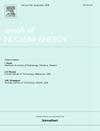Experimental study on light gas transport during containment venting by using the large-scale test facility CIGMA
IF 1.9
3区 工程技术
Q1 NUCLEAR SCIENCE & TECHNOLOGY
引用次数: 0
Abstract
Containment venting is one of the accident mitigation measures during severe accidents in nuclear power plants for preventing overpressure failure of the containment vessels. Because of the capability of releasing hydrogen generated in the containment vessel, the hydrogen risk can be also reduced. In this study, we conducted experiments with the large-scale test facility CIGMA to investigate the light gas transport during the venting action, mainly focusing on the effect of sump water boiling caused by the vent. The CIGMA test vessel initially pressurized by steam, air, and helium (hydrogen simulant) that formed a helium-rich density stratification was depressurized with and without sump water, with different venting flow rates, and at different venting positions. As the sump water became a steam source due to flash boiling, the helium stratification was diluted and the venting time increased twofold compared to the case without sump water, which significantly affected the amount of helium discharged to the atmosphere. Especially for the high venting flow rate condition, the amount of helium remaining in the vessel at the end of depressurization was half that of the case without sump water. Lowering the venting position from within the initial stratification to 3 m below its interface led to a threefold increase in the amount of helium remaining at the same low pressure, because of the longer time until the helium-rich stratification reached the venting position.
大型试验装置CIGMA对安全壳排气过程中轻气体输运的试验研究
安全壳排气是核电站重大事故中防止安全壳超压失效的事故缓解措施之一。由于能够释放安全壳中产生的氢气,因此也可以降低氢气风险。在本研究中,我们利用大型试验设施CIGMA进行了实验,研究了排气过程中轻气体的输运,主要研究了排气对污水沸腾的影响。CIGMA试验容器最初由蒸汽、空气和氦气(氢气模拟物)加压,形成富氦密度分层,在有和没有污水、不同排气流量、不同排气位置进行降压。由于贮水池水因闪沸而成为蒸汽源,使氦分层被稀释,排气时间比无贮水池水的情况增加了两倍,这对氦排入大气的量有显著影响。特别是在高排气流量条件下,减压结束时容器内剩余的氦气量是无贮水池情况的一半。由于富氦层状到达排气位置所需的时间较长,将排气位置从初始层状内部降低到其界面以下3 m处,在相同的低压下剩余氦的数量增加了3倍。
本文章由计算机程序翻译,如有差异,请以英文原文为准。
求助全文
约1分钟内获得全文
求助全文
来源期刊

Annals of Nuclear Energy
工程技术-核科学技术
CiteScore
4.30
自引率
21.10%
发文量
632
审稿时长
7.3 months
期刊介绍:
Annals of Nuclear Energy provides an international medium for the communication of original research, ideas and developments in all areas of the field of nuclear energy science and technology. Its scope embraces nuclear fuel reserves, fuel cycles and cost, materials, processing, system and component technology (fission only), design and optimization, direct conversion of nuclear energy sources, environmental control, reactor physics, heat transfer and fluid dynamics, structural analysis, fuel management, future developments, nuclear fuel and safety, nuclear aerosol, neutron physics, computer technology (both software and hardware), risk assessment, radioactive waste disposal and reactor thermal hydraulics. Papers submitted to Annals need to demonstrate a clear link to nuclear power generation/nuclear engineering. Papers which deal with pure nuclear physics, pure health physics, imaging, or attenuation and shielding properties of concretes and various geological materials are not within the scope of the journal. Also, papers that deal with policy or economics are not within the scope of the journal.
 求助内容:
求助内容: 应助结果提醒方式:
应助结果提醒方式:


